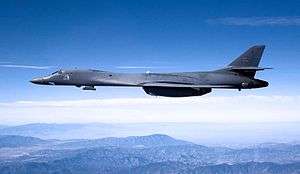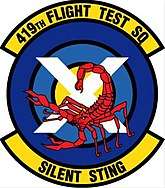419th Flight Test Squadron
The 419th Flight Test Squadron is a United States Air Force squadron. It is assigned to the 412th Operations Group, Air Force Materiel Command, stationed at Edwards Air Force Base, California.
419th Flight Test Squadron
 | |
|---|---|
 419th Flight Test Squadron – Rockwell B-1B Lancer 85-75
419th Flight Test Squadron – B-2 Spirit | |
| Active | 1942–1945; 1958–1962; 1989–present |
| Country | |
| Branch | |
| Type | Squadron |
| Role | Flight Testing |
| Part of | Air Force Materiel Command |
| Garrison/HQ | Edwards Air Force Base, California |
| Motto(s) | Silent Sting |
| Engagements | European Theater of Operations Mediterranean Theater of Operations[1] |
| Decorations | Distinguished Unit Citation Air Force Outstanding Unit Award[1] |
| Insignia | |
| 419th Flight Test Squadron emblem (approved 21 February 1990)[1] |  |
| 419th Bombardment Squadron emblem (approved 11 August 1961)[1] |  |
| Tail code | ED |
| Aircraft flown | |
| Bomber | B-2 Spirit B-1 Lancer B-52 Stratofortress |
During World War II, the 419th Bombardment Squadron was a Boeing B-17 Flying Fortress squadron, assigned to the 301st Bombardment Group, Fifteenth Air Force. It earned Two Distinguished Unit Citations. In 1958, the squadron was activated as a Boeing B-47 Stratojet squadron as part of Strategic Air Command's nuclear force, but was discontinued four years later. In 1993, the squadron was consolidated with the 6519th Test Squadron, which had been conducting test operations at Edwards since 1989.
Overview
The 419th performs flight testing on B-2 Spirit, B-1 Lancer, and Boeing B-52 Stratofortress strategic bombers.
History
World War II
Established as a Boeing B-17 Flying Fortress heavy bombardment squadron in early 1942; trained under Second Air Force. Flew antisubmarine patrols off the California coast from, late May–early June 1942, then over the Mid-Atlantic coast during June–July 1942.[2]
Deployed to European Theater of Operations (ETO) in August 1942, being assigned to VIII Bomber Command, one of the first B-17 heavy bomb squadrons assigned to England. Engaged in strategic bombardment operations over Occupied Europe attacking enemy military and industrial targets. Reassigned to Mediterranean Theater of Operations (MTO) as part of Operation Torch invasion of North Africa. Operated from desert airfields in Algeria and Tunisia during North African and Tunisian campaign. Assigned to Northwest African Strategic Air Force during Invasion of Sicily and later Italy in 1943. Allocated to Fifteenth Air Force for strategic bombing of Nazi Germany and occupied Europe. Attacked enemy targets primarily in the Balkans; Southern France; Southern Germany and Austria from southern Italy; engaged in shuttle bombing missions to airfields in the Soviet Union during the summer of 1944.[3][4]
Personnel largely demobilized after German capitulation in May 1945; squadron reassigned to the United States and was programmed for conversion to B-29 Superfortess operations and deployment to Pacific Theater, plans canceled after Japanese capitulation in August 1945. Aircraft sent to storage and unit inactivated largely as a paper unit in October 1945.[2][5]
Strategic Air Command
From 1958, the Boeing B-47 Stratojet wings of Strategic Air Command (SAC) began to assume an alert posture at their home bases, reducing the amount of time spent on alert at overseas bases. The SAC alert cycle divided itself into four parts: planning, flying, alert and rest to meet General Thomas S. Power's initial goal of maintaining one third of SAC’s planes on fifteen minute ground alert, fully fueled and ready for combat to reduce vulnerability to a Soviet missile strike.[6] To implement this new system B-47 wings reorganized from three to four squadrons.[6][7] The 419th was activated at Lockbourne Air Force Base as the fourth squadron of the 301st Bombardment Wing. The alert commitment was increased to half the squadron's aircraft in 1962 and the four squadron pattern no longer met the alert cycle commitment, so the squadron was inactivated on 1 January 1962.[7]
Flight Test Squadron
Reactivated as a flight test squadron at Edwards AFB in 1989 taking over the Air Force Flight Test Center Strategic Systems Division (B-52G/H Stratofortress). Also operated UAV test program (MQ-1 Predator) 1994–2000 when the UAV program was realigned. Gained B-1 Lancer program from the 410th Flight Test Squadron in 1991 when the 410th was moved to Palmdale and took over the F-117 Program. Gained B-2 Spirit program from the inactivating 420th Flight Test Squadron on 30 December 1997.[8]
Lineage
- 419th Bombardment Squadron
- Constituted as the 29th Reconnaissance Squadron (Heavy) on 28 January 1942
- Activated on 3 February 1942
- Redesignated 419th Bombardment Squadron (Heavy) on 22 April 1942
- Redesignated 419th Bombardment Squadron, Heavy c. 6 March 1944
- Redesignated 419th Bombardment Squadron, Very Heavy on 5 August 1945
- Inactivated on 15 October 1945
- Redesignated 419th Bombardment Squadron, Medium on 20 August 1958
- Activated on 1 December 1958
- Discontinued and inactivated on 1 January 1962
- Consolidated with the 6519th Test Squadron as the 6519th Test Squadronon 1 October 1992[1]
- 419th Flight Test Squadron
- Designated as the 6519th Test Squadron and activated, on 10 March 1989
- Consolidated with the 419th Bombardment Squadron on 1 October 1992
- Redesignated 419th Test Squadron on 2 October 1992
- Redesignated 419th Flight Test Squadron on 1 March 1994[1]
Assignments
- 301st Bombardment Group, 3 Feb 1942 – 15 Oct 1945
- 301st Bombardment Wing, 1 Dec 1958 – 1 Jan 1962
- 6510th (later, 412th) Test Wing, 10 March 1989
- 412th Operations Group, 1 Oct 1993–Present[1]
Stations
|
|
Aircraft
See also
References
- Notes
- "Factsheet 419 Flight Test Squadron". Air Force Historical Research Agency. 7 April 2008. Retrieved 10 July 2017.
- Maurer, Combat Squadrons, p. 514
- Millet,
- Freeman,
- Pimlott,
- Schake, p. 220 (note 43)
- "Abstract (Unclassified), History of the Strategic Bomber since 1945 (Top Secret, downgraded to Secret)". Air Force History Index. 1 April 1975. Retrieved 4 March 2014.
- Rogers,
Bibliography
![]()
- Freeman, Roger A. (1978) Airfields of the Eighth: Then and Now. After the Battle ISBN 0-900913-09-6
- Maurer, Maurer, ed. (1983) [1961]. Air Force Combat Units of World War II (PDF) (reprint ed.). Washington, DC: Office of Air Force History. ISBN 0-912799-02-1. LCCN 61060979.
- Maurer, Maurer, ed. (1982) [1969]. Combat Squadrons of the Air Force, World War II (PDF) (reprint ed.). Washington, DC: Office of Air Force History. ISBN 0-405-12194-6. LCCN 70605402. OCLC 72556.
- Millet, Jeffrey R. The Fifteenth Air Force Story: A History 1943–1985. Fifteenth Air Force Association, 1986.
- John Pimlott, B-29 Superfortress, Gallery Books, 1980.
- Rogers, Brian. (2005). United States Air Force Unit Designations Since 1978. Hinkley, UK: Midland Publications. ISBN 1-85780-197-0.
- Schake, Col Kurt W. (1998). Strategic Frontier: American Bomber Bases Overseas, 1950–1960 (PDF). Trondheim, Norway: Norwegian University of Science and Technology. ISBN 978-8277650241. Retrieved 27 July 2015.


